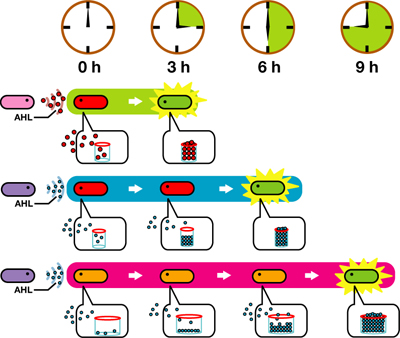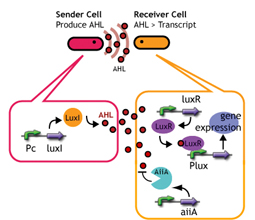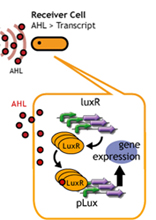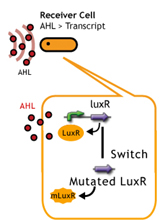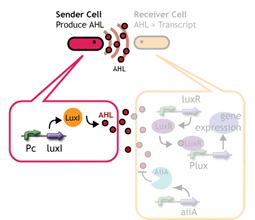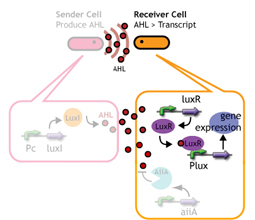Team:Chiba/Project
From 2008.igem.org
(→Conclusion) |
(→Conclusion) |
||
| Line 120: | Line 120: | ||
*結局もっと時間があるとしたら、どの実験がいちばんゆうぼうそうでしょうか?それはなぜ? | *結局もっと時間があるとしたら、どの実験がいちばんゆうぼうそうでしょうか?それはなぜ? | ||
| + | #Make a gene circuit of positive feed back loop connected quorum sensing(レシーバもセンダーも).レシーバにポジティブフィードバックを導入すれば、実験では十分な蛍光強度に達しなかったLasR,CinR,RhlRも十分な蛍光を示すようになる[[Team:Chiba/Project#References|(8),(9)]] | ||
#Down-tune the Autoinducer synthase activity putting its gene into low-copy plasmid or by giving the low efficiency RBS.「蓄積したAHLによってあるときに初めてONになるスイッチ」であるのに、レポータの発現が遅い(一方でAHLの合成は速い)ために、蓄積部分を観測できない. | #Down-tune the Autoinducer synthase activity putting its gene into low-copy plasmid or by giving the low efficiency RBS.「蓄積したAHLによってあるときに初めてONになるスイッチ」であるのに、レポータの発現が遅い(一方でAHLの合成は速い)ために、蓄積部分を観測できない. | ||
#LuxR mutation(receiver). | #LuxR mutation(receiver). | ||
| - | |||
#Down-tune the AiiA activity (either by putting this gene into low-copy plasmid or by giving the low efficiency RBS. | #Down-tune the AiiA activity (either by putting this gene into low-copy plasmid or by giving the low efficiency RBS. | ||
*もうこれはあかんな! 投資価値の無い戦略はどれかな? で、そうおもうのは何故? | *もうこれはあかんな! 投資価値の無い戦略はどれかな? で、そうおもうのは何故? | ||
Revision as of 06:16, 30 October 2008
| Home | The Team | The Project | Parts Submitted to the Registry | Reference | Notebook | Acknowledgements |
|---|
Abstract
E.coli time manager
We are constructing delay switches to control/preset the timing of target gene expression. Our project uses two classes of bacteria: senders and receivers. Senders produce signaling molecules, and receivers are activated only after a particular concentration of this molecule is reached. The combinatorial use of senders/receivers allows us to make a‘switching consortium’which activates different genes at the preset times.
As signaling molecules, we utilize molecules associated with Quorum sensing, a phenomenon that allows bacteria to communicate with each other. Although different quorum sensing species have slightly different signaling molecules, these molecules are not completely specific to their hosts and cross-species reactivity is observed (1),(2). Communication using non-endogenous molecules is less sensitive than the original, and requires a higher signal concentration to take effect. This reduced sensitivity results in the slower activation of receivers, thus creating a system in which different receivers are activated after different amounts of time following signaling molecule release.
Introduction
Many electronic devices we use in our daily lives have the ability to keep track of time. For example, a VCR is able to record a TV program at a pre-set time, and a microwave automatically stops heating after a set amount of time. automatically stop heating when the right time comes. Using these temporal pre-programming functions, we have been liberated from either staying up late to watch a European soccer game or from worrying about our popcorn being burned black while yelling and shouting to the match we have videotaped. In this way, the timer function has revolutionized our lifestyle.
We thought the same applies to the biotechnology; we would like to freely implement the 'timer switches” to various biological functions, preferably both independently and in parallel format. These “functions” include sensors, synthesizers, or degraders of bioactive compounds/ materials, transportation and secretion machineries, communications, getting/ sticking together, proliferation and cell death. If successful, we will be able to program exceedingly more complex complex behaviors in cellular systems.
Project Design
We designed a switching consortium that works like a water clock ([http://en.wikipedia.org/wiki/Water_clock Water clock-wikipedia.en]). Here is how it works (Fig 3).
1. Sender cells slowly generate signal molecules at a constant rate. The signal molecules are non-degradable (or virtually so in a reasonable time scale) so they get accumulated (linearly) over time.
2. Receivers detect the signal molecules and then activate the genetic switch to the on state, but only when the signal concentration reaches the switching threshold of a receiver. Receivers are activated by different signaling molecules at different rates. In this way, the entire system behaves like a delay switch sequence.
3. Either by changing the receiver sensitivity or rate of signal accumulation, one can freely control the delay length of the individual switches. Using switches with various times-of-delay, one can sequentially activate many different cellular functions.
Signaling System
In this project, we use acylated homoserine lactones (AHLs), signaling molecules used for [http://en.wikipedia.org/wiki/Quorum_sensing quorum sensing] in gram negative bacteria. Senders express LuxI or similar enzymes, which catalyze the production of AHLs, under the control of a constitutive (Tet) promoter. Each cell thus generates AHL more or less at a constant rate. AHL can freely permeate cell membranes and are detected by neighboring cells. Receivers constitutively express LuxR proteins (or a similar ortholog), the protein that detects AHL concentrations. When AHLs bind LuxR proteins, the AHL-LuxR complex activates the Lux promoter. The threshold [AHL] at which switching occurs is determined by the affinity of AHL for the particulr LuxR ortholog.(3),(4). (more about quorum sensing)
Constructing A Delay Switch, three ways:
- Speaker whispering
- Desensitize Receiver
- jamming by AiiA (decomposer)
List of Experiments
Delay Switching by Tuning Components
|
|
|
Delay Switching by CrossTalk(7)
Miscs
Temporal imaging system?
Conclusion
Futher variation of delayed switches will be realized:
- 結局もっと時間があるとしたら、どの実験がいちばんゆうぼうそうでしょうか?それはなぜ?
- Make a gene circuit of positive feed back loop connected quorum sensing(レシーバもセンダーも).レシーバにポジティブフィードバックを導入すれば、実験では十分な蛍光強度に達しなかったLasR,CinR,RhlRも十分な蛍光を示すようになる(8),(9)
- Down-tune the Autoinducer synthase activity putting its gene into low-copy plasmid or by giving the low efficiency RBS.「蓄積したAHLによってあるときに初めてONになるスイッチ」であるのに、レポータの発現が遅い(一方でAHLの合成は速い)ために、蓄積部分を観測できない.
- LuxR mutation(receiver).
- Down-tune the AiiA activity (either by putting this gene into low-copy plasmid or by giving the low efficiency RBS.
- もうこれはあかんな! 投資価値の無い戦略はどれかな? で、そうおもうのは何故?
- Rhizobium leguminosarum由来のCinシリーズではほとんどクロストークしていないことがわかった。(分子の構造が違いすぎるからか?)Cinシリーズでの実験は必要はないと判断した.
- あと、「少なくともわたしたちは、これだけの成果はあげました」というまとめ
- When we used the cross-talk strategy using 3OC12HSL instead of 3OC6HSL, the delayed switch worked 2 hours after the original switch worked.
- 13個の基本的な、でも便利なパーツを作っった。それらを使えば、delayが作れるのだ。
- delayed switchについてミズーリ
- ミズーリは時間調節が容易なタイマーである.しかし、ON/OFF不可.
千葉のタイマーは...
ON/OFFが使える.蓄積型タイマーである.
(じゃあなぜラクトースを使わなかったか.)
References
- [http://www3.interscience.wiley.com/journal/119124142/abstract M.K Winson et al.:Construction and analysis of luxCDABE-based plasmid sensors for investigating N-acyl homoserine lactone-mediated quorum sensing.FEMS Microbiology Letters 163 (1998) 185-192]
- [http://partsregistry.org/Part:BBa_F2620:Specificity BBa_F2620:Specificity]
- [http://www.pnas.org/content/100/suppl.2/14549.full Michiko E. Taga. Bonnie L.Bassler.:Chemical communication among bacteria.PNAS.November 25, 2003,100.suppl.2]
- [http://arjournals.annualreviews.org/doi/abs/10.1146/annurev.micro.55.1.165?url_ver=Z39.88-2003&rfr_id=ori:rid:crossref.org&rfr_dat=cr_pub%3dncbi.nlm.nih.gov Melissa B. Miller and Bonnie L. Bassler.:QUORUM SENSING IN BACTERIA.annurev.micro.55.1.165.2001]
- [http://authors.library.caltech.edu/5553/ C. H. Collins.et al.:Directed evolution of Vibrio fischeri LuxR for increased sensitivity to a broad spectrum of acyl-homoserine lactones.Mol.Microbiol.2005.55(3).712–723]
- [http://mic.sgmjournals.org/cgi/content/abstract/151/11/3589 B. Koch. et al.:The LuxR receptor: the sites of interaction with quorum-sensing signals and inhibitors.Microbiology 151 (2005),3589-3602]
- [http://mic.sgmjournals.org/cgi/content/full/153/12/3923 Paul Williams :Quorum sensing, communication and cross-kingdom signalling in the bacterial world.Microbiology 153 (2007), 3923-3938]
- [http://pubs.acs.org/cgi-bin/abstract.cgi/acbcct/2006/1/i11/abs/cb6004245.html D. J. Sayut et al.:Construction and Engineering of Positive Feedback Loops.ACS Chemical Biology.1.No.11.(2006)]
- [http://www.sciencedirect.com/science?_ob=ArticleURL&_udi=B6WBK-4PRHJ6K-2&_user=136872&_rdoc=1&_fmt=&_orig=search&_sort=d&view=c&_version=1&_urlVersion=0&_userid=136872&md5=3ed7ffab9f831d102f5e99353843c080 D. J. Sayut et al.:Noise and kinetics of LuxR positive feedback loops.Biochem. Biophys. Res. Commun.363(3),2007,667-673.]
| Home | The Team | The Project | Parts Submitted to the Registry | Reference | Notebook | Acknowledgements |
|---|
 "
"



